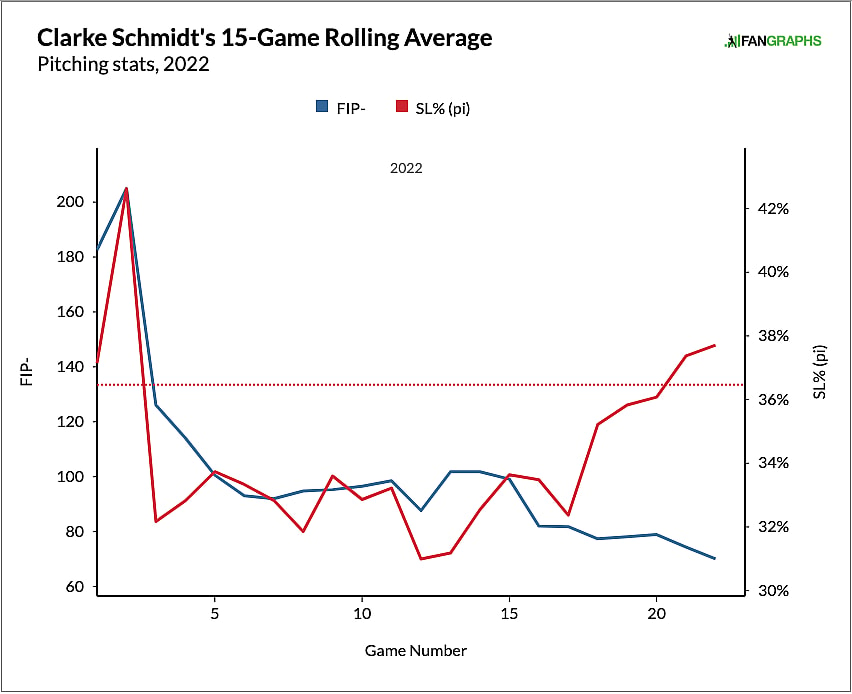
In 2017 Clarke Schmidt was drafted by the Yankees out of the University of South Carolina in the 1st round, there were high hopes for the righty. He had injury issues that lowered his draft stock, but the velocity and electric stuff where always there.
Schmidt had eye-popping spin rates on his fastball, and for many, that would make his fastball the pitch that would cause his ascent; but it’s been the complete opposite. His slider has established itself as his best pitch, but can a slider be a primary pitch instead of a fastball?
Well, the short answer is yes! Clarke Schmidt is part of a growing sector of pitchers who aren’t fastball first guys in a league where sliders are being used more than ever, and fastballs are being used less than ever before.
- Yankees News & Buzz: Aaron Boone discusses roster; why Yanks didn’t make an offer to Luke Weaver, more
- How acquiring Freddy Peralta turns the Yankees’ rotation into a World Series juggernaut
- Yankees manager says team still has unfinished business in the offseason
Baseball is becoming slider dominant
Major League Baseball has seen the slider have a meteoric rise in the last few years. The pitch’s popularity came about in the latter half of the 2010s, with the usage of the pitch climbing rapidly:
- 2017: 16.3%
- 2018: 16.9%
- 2019: 18.3%
- 2020: 18.8%
- 2021: 20.1%
- 2022: 21.8%
Slider usage is up over 5% since 2017, but why the slider and not other breaking pitches? Simply put, throwing a slider is the most similar breaking pitch to throwing a fastball. Pitchers have found more comfort with repeating their slider mechanics and having strong command, thus, the pitch became very popular as a potential primary pitch option. They also are, on average, a better pitch than a fastball, as gyro sliders average a whopping 120 Stuff+, and sweeping sliders average a 162 Stuff+. For a visual example, try to determine which pitch is easier to hit:
Let me answer that question for you; the harder pitch to make contact with here is the slider, and PitchingBot’s Expected Whiff% agrees with my pre-conceived notion. It has a 36% xWhiff% (if swung at), while the sinker has just a 15% xWhiff% (if swung at). In terms of results this season, his slider has outperformed his sinker by a wide margin.
Slider:
- 42.6% Whiff%
- .158 BA
- .175 SLG
- .198 wOBA
Sinker:
- 14.4% Whiff%
- .314 BA
- .435 SLG
- .401 wOBA
If you’re Clarke Schmidt, why throw the sinker when you can throw the slider? For many pitchers, this became the question that changed how frequently they used their pitches.
Clarke Schmidt’s success with this increased slider usage
Clarke Schmidt began using his slider more frequently in the month of July, and that usage correlates with better results.

FIP- is Fielding Independent Pitching which uses the pitcher’s ratio of strikeouts, walks, and home runs but placed on an index. 100 is average, and 80 would be 20% better than average (100 minus 80 is 20), whereas 120 would be 20% worse than average (120 minus 100 is 20). Lower is better, like with ERA, and Schmidt’s FIP- drops dramatically as his slider usage skyrockets. His strikeouts are up, walks are down, while home runs remain unaffected since he rarely gave them up anyways. Since July, Schmidt’s number across the board have improved a ton:
- 3.0% Barrel%
- 2.19 ERA
- 2.10 FIP
- 3.36 xFIP
- 3.37 SIERA
- 17.8% K-BB%
Schmidt’s a much better pitcher now, and that’s because he’s using his best pitch far more often. Eno Sarris of The Athletic (creator of Stuff+) puts it best, discussing how the easiest way to improve your Stuff is to improve our pitch usage. Schmidt is vying for a spot in the rotation next season, and the reliance on his slider could be the reason he becomes the pitcher the Yankees always believed he could be.
More about: New York Yankees